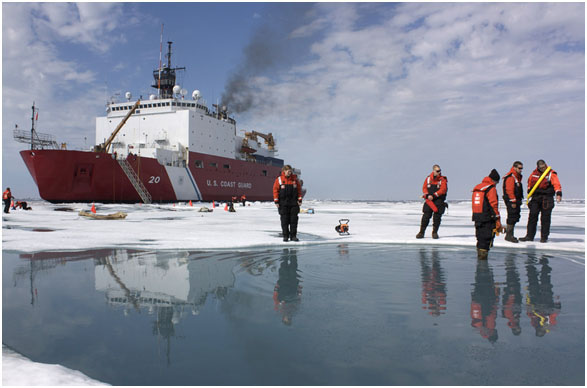
Pondering a pond of water where solid ice should be. (Photo courtesy NASA)
In just eight mid-February days, nearly a third of the sea ice covering the Bering Sea off Alaska’s west coast vanished. The loss of ice — a symptom of the changing climate as the planet warms — seriously affects the lives of people who live along the coast.
Subsistence hunting is a way of life on coastal islands. With no land animals to hunt, islanders rely on whale meat for survival. Ice too thin to support hunters and prey can mean the difference between feeding a family and starving. The annual whaling season normally wraps up by Thanksgiving, but in 2017 the ice formed later than ever before, and the first whale of the season was not harvested until early last month.
Since 2000, Arctic sea-ice decline has been accelerating. In February, sea ice should be growing toward its maximum extent for the year. Instead, it is shrinking. This year’s Bering Sea ice cover is barely 40 percent of the 1981-2010 average.
As for the Atlantic side, the Feb. 23 temperature in northern Greenland reached 43 degrees Fahrenheit, normal for May. (The February average high temperature there used to be minus 20 degrees F., or 63 degrees F. colder. It’s as if a 91 degrees F. February day hit Portland, Maine.) By Feb. 25, North Pole temperatures also rose above freezing, making the pole considerably warmer than Europe.
Across much of the Arctic, July-like temperatures — on average 45 degrees F. above normal — affect tens of thousands of square miles. Permafrost is melting at a record rate in the Arctic tundra, releasing methane, which only compounds the warming.
In its peer-reviewed 2018 “Arctic Report Card” — an annual publication since 2006 — NOAA scientists reported that the average surface air temperature for the year ending September 2017 was the second warmest since 1900. The sea-ice cover is relatively young and thin. Older, thicker ice comprised only 21 percent of the ice cover in 2017 compared with 45 percent in 1985. August surface temperatures in the Chukchi and Barents seas were 7.2 degrees F. warmer than average, delaying the autumn freeze-up.
Scientists emphasize that these recent warm temperatures are no aberration. They are part of a trend toward a radically different planet — the Arctic shows no sign of returning to its reliably frozen past.
Changes in the Arctic affect the global ecosystem. Take ocean currents, for example — the so-called global ocean conveyor belt. Movement of these currents is driven mostly by differences in water temperature. Cold water is dense and heavy. It sinks to the bottom of the ocean. Warm water is less dense, and lighter, so it remains on the surface.
As it approaches the Norwegian Sea, the warm water of the Gulf Stream continually loses heat to the atmosphere of cold northern latitudes. As the water cools, it sinks to the bottom of the ocean, only to be replaced by more warm surface water from the south. Meanwhile, the cold bottom water flows south, past the equator, mixing with warmer waters along the way. Eventually it returns to the surface as part of the conveyor belt that encircles the globe.
What if a warming sub-Arctic atmosphere stopped cooling the warm Gulf current sufficiently for the water to sink with enough force to drive the global ocean conveyor belt? Just asking. Must we idly wait to experience such complex worldwide climate effects?
In Maine, we consume $6 billion worth of imported, climate-changing fossil fuels every year. That’s more than $17,000 per four-person family per year. Of this, the housing/building sector consumes 40 percent, worth an annual $2.4 billion. Home and building owners — that’s us! — are 100 percent responsible for how we spend this huge amount. Let’s spend it on permanent energy improvements to our homesteads instead. Nothing can stop us but the limits of our imagination.
Stay tuned for details.
(Paul Kando is a co-founder of the Midcoast Green Collaborative, which works to promote environmental protection and economic development via energy conservation. For more information, go to midcoastgreencollaborative.org.)



